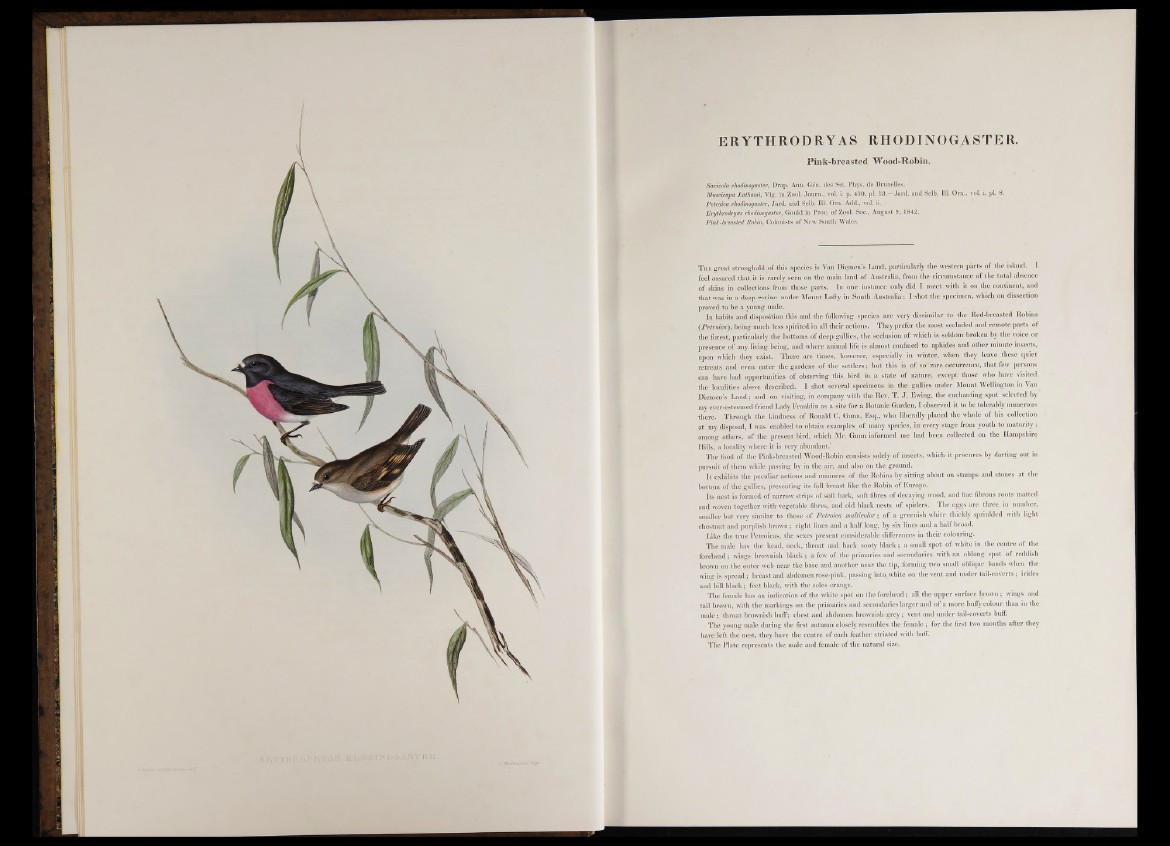
ERYTHRODRYAS RHODINOGASTER.
Pink-breasted Wood-Robin.
Saxícola rhodinogaster, Drap. Ann. Gen. des Sci. Phys. de Bruxelles.
Muscícapa Lathami, Vig. in Zool. Journ., vol. i. p. 410. pi. 13.—Jard. and Selb. I1L Om., vol. i. pi. 8.
Petroica rhodinogaster, Jard. and Selb. 111. Om. Add., vol. ii.
Erythrodryas rhodinogaster, Gould in Proc. of Zpol. Soc., August 9, 1842.
Pink-breasted Robin, Colonists of New South Wales.
T he great stronghold o f this species is Yan Diemen’s Land, particularly the western parts o f the island. I
feel assured that it is rarely seen on the main land of Australia, from the circumstance o f the total absence
o f skins in collections from those parts. In one instance only did I meet with it on the continent, and
that was in a deep ravine under Mount Lofty in South Australia; I shot the specimen, which on dissection
proved to be a young male.
In habits and disposition this and the following species are very dissimilar to the Red-breasted Robins
(Petroica'), being much less spirited in all their actions. They prefer the most secluded and remote parts of
the forest, particularly the bottoms o f deep gullies, the seclusion o f which is seldom broken by the voice or
presence o f any living being, and where animal life is almost confined to aphides and other minute insects,
upon which they exist. There are times, however, especially in winter, when they leave these quiet
retreats and even enter the gardens of the settlers; but this is o f so*rare occurrence, that few persons
can have had opportunities of observing this bird in a state of nature, except those who have visited
the localities above described. I shot several specimens in the gullies under Mount Wellington in Van
Diemen’s Land; and on visiting, in company with the Rev. T. J. Ewing, the enchanting spot selected by
my ever-esteemed friend Lady Franklin as a site for a Botanic Garden, I observed it to be tolerably numerous
there. Through the kindness of Ronald C. Gunn, Esq., who liberally placed the whole o f his collection
at my disposal, I was enabled to obtain examples of many species, in every stage from youth to maturity ;
among others, of the present bird, which Mr. Gunn informed me had been collected on the Hampshire
Hills, a locality where it is very abundant.'
The food of the Pink-breasted Wood-Robin consists solely of insects, which it procures by darting out in
pursuit of them while passing by in the air; and also on the ground.
It exhibits the peculiar actions and manners o f the Robins by sitting about on stumps and stones at the
bottom o f the gullies, presenting its full breast like the Robin o f Europe.
Its nest is formed o f narrow strips of soft bark, soft fibres of decaying wood, and fine fibrous roots matted
and woven together with- vegetable fibres, and old black nests o f spiders. The eggs are three in number,
smaller but very similar to those of Petroica multicolor; of a greenish white thickly sprinkled with light
chestnut and purplish brown; eight lines and a half long, by six lines and a half broad.
Like the true Petroicas, the sexes present considerable differences in their colouring.
The male has the head, neck, throat and back sooty black; a small spot of white in the centre o f the
forehead; wings brownish black ; a few of the primaries and secondaries with an oblong spot of reddish
brown on the outer web near the base and another near the tip, forming two small oblique bands when the
wing is spread; breast and abdomen rose-pink, passing into, white on the vent and under tail-coverts; irides
and bill black; feet black, with the soles orange.
The female has an indication o f the white spot on the forehead; all the upper surface brown; wings and
tail brown, with the markings on the primaries and secondaries larger and of a more buffy colour than in the
male ; throat brownish buff; chest and abdomen brownish• grey; vent and under tail-coverts buff.
The young male during the first autumn closely resembles the female ; for the first two months after they
have left the nest, they have the centre o f each feather striated with buff.
The Plate represents the male and female o f the natural size.